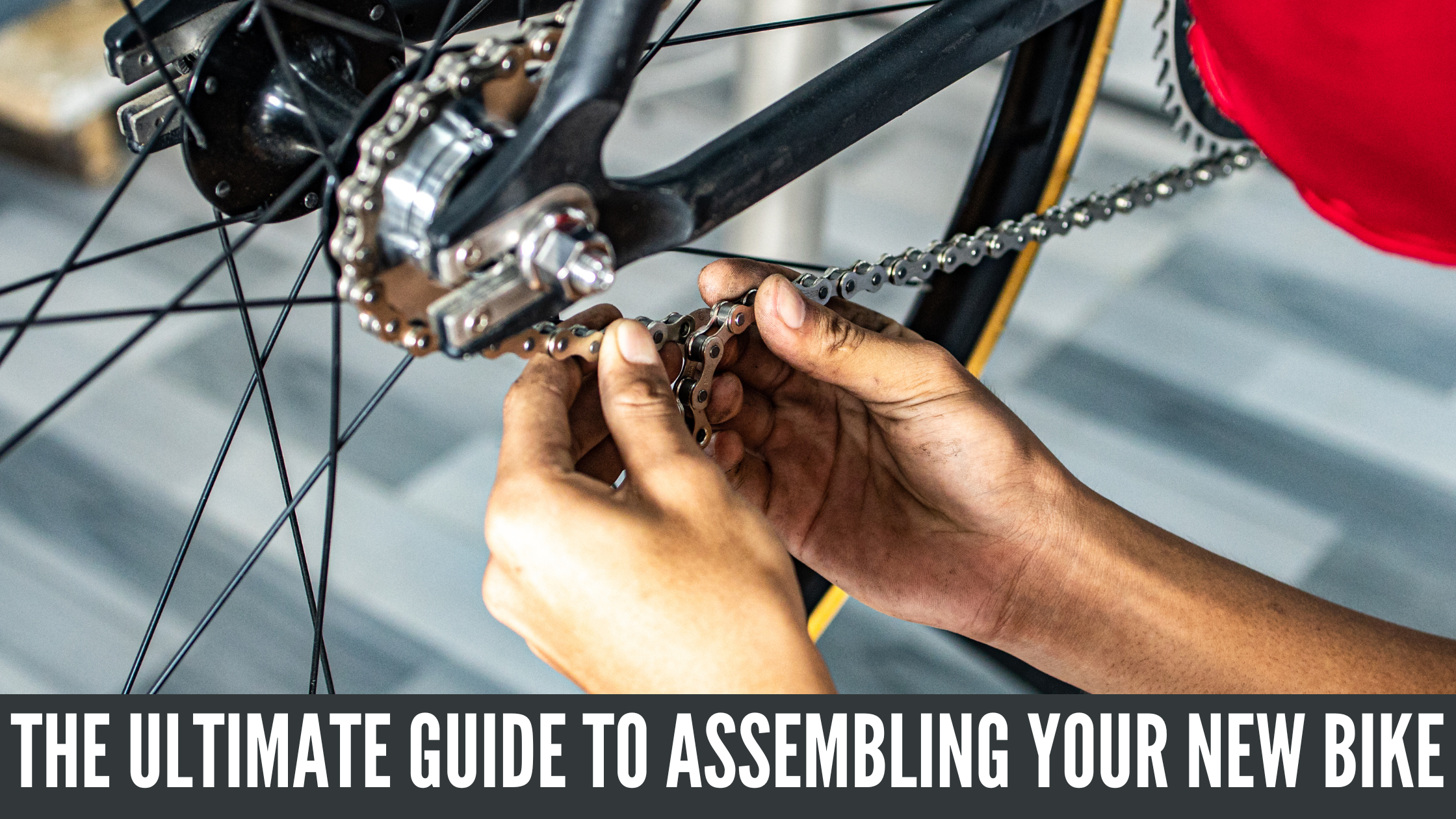Congrats on your new bike from Chico Bikes! Now that it’s arrived, you’re just a few steps away from cruising the streets on your fresh set of wheels. While the idea of assembling a bike might sound like a daunting task — especially for beginners — this ultimate guide will walk you through the entire process, step by step. Whether you’re handy with tools or this is your first-ever bike, you’ll have your new ride ready in no time.
We’ll also throw in a few assembly tips and troubleshooting advice to make sure everything goes smoothly. Ready to get started? Let’s jump in.
Step 1: Gather Your Tools
The first step is making sure you have all the right tools on hand. While some Chico Bikes models come with basic tools, you may want to use your own to ensure everything is secure. Here’s what you’ll need:
Essential Tools:
- Allen keys/hex wrenches: Typically 4mm, 5mm, and 6mm sizes.
- Open-end or adjustable wrench: For tightening pedals (usually 15mm).
- Screwdrivers: Phillips and flathead.
- Bike pump: For inflating tires to the proper pressure.
- Grease or anti-seize lubricant: Optional but useful for assembling components like pedals and bolts, reducing the risk of rust and easing future maintenance.
Nice-to-Have Tools:
- Torque wrench: For making sure you don’t overtighten bolts. If you don’t have one, use caution to avoid overtightening, especially on delicate parts like the handlebars and seat post clamp.
- Pedal wrench: If you have one, this makes pedal installation a breeze.
- Stand or bike repair stand: If you have a bike stand, it makes assembly more comfortable and easier, especially when working on the wheels and pedals. But if not, resting the bike on the ground works just fine.
Pro Tip: Keep a clean, well-lit workspace. Clear some space where you can lay out all the parts and tools before starting. This helps prevent misplacing bolts or small pieces that are easy to lose.
Step 2: Unbox Your Bike and Check the Components
Excitement is building, but before you start assembling, it’s important to unbox everything carefully. Lay out all the components to make sure you have everything you need. Here’s what should be in the box:
Key Components:
- Bike frame: This will likely come partially assembled.
- Front and rear wheels: Some models may already have the rear wheel attached.
- Handlebars: May be attached to the bike, but not fully secured or aligned.
- Seat and seat post: Usually separate.
- Pedals: Packed individually and labeled for right (R) and left (L).
- Reflectors and other accessories: These may include lights, bells, or other add-ons.
- Assembly instructions: These are your step-by-step guide. Keep them handy!
Before You Discard Any Packaging:
Check for any small parts, like bolts, reflectors, or even small tools, that may be tucked into the foam or taped to the box. It’s not uncommon for screws or pedals to be packed separately, so take your time opening the box to avoid losing anything.
Pro Tip: Save the box for a few days in case you need to return or exchange anything. Plus, if you’re assembling the bike indoors, it can protect your floors from grease or scuffs.
Step 3: Install the Handlebars
Now that everything is laid out, it’s time to start assembling your new bike. First up: the handlebars. This is a crucial step since the handlebars control your bike’s direction and comfort while riding. Follow these steps for a smooth installation:
How to Install the Handlebars:
-
Loosen the stem bolts: Most Chico Bikes will have a stem already attached to the frame. Use your Allen key to loosen the bolts on the stem where the handlebars will be inserted. Be sure to keep the bolts safe while they’re out.
-
Attach the handlebars: Slide the handlebars into the stem clamp. Make sure the handlebars are centered and aligned with the front fork (the prongs that hold the front wheel).
-
Align the handlebars: Stand over the bike and check that the handlebars are perpendicular to the front wheel. This ensures the bike steers straight.
-
Tighten the bolts: Once aligned, tighten the stem bolts evenly using your Allen key. Tighten them gradually in a crisscross pattern to ensure even pressure.
Pro Tip: If your handlebars feel wobbly or loose, double-check that the stem bolts are secure but not overtightened. If you overtighten them, it can strip the threads or cause damage to the components.
Step 4: Attach the Front Wheel
Now that the handlebars are secure, it’s time to give your bike some mobility by attaching the front wheel. Most bikes come with the rear wheel already attached, so this step should be pretty straightforward.
Steps to Attach the Front Wheel:
-
Position the bike: For easier installation, place the bike frame on a sturdy surface (or use a bike stand if available). Lift the front end slightly to make room for the front wheel.
-
Insert the front wheel: If your bike has a quick-release skewer, remove it first. Then align the front wheel with the fork dropouts (the two prongs at the bottom of the fork). Slide the wheel into place.
-
Tighten the quick-release: Insert the skewer through the hub of the wheel and fasten it by turning the lever. Make sure the lever is tightened securely, but it should still be easy enough to release by hand.
-
For bikes with axle nuts: If your bike uses axle nuts instead of a quick-release, use a wrench to tighten the nuts on both sides of the axle. Make sure the wheel is centered between the fork prongs before tightening.
Pro Tip: After installing the wheel, spin it to ensure it moves freely and doesn’t rub against the brakes. If the brakes are rubbing, don’t worry — we’ll adjust them in the next step.
Step 5: Adjust and Install the Brakes
Before taking your bike for a ride, you need to make sure the brakes are set up correctly. Whether you have disc brakes, rim brakes, or V-brakes, proper installation is crucial for safety. Most bikes from Chico Bikes come with brakes pre-installed, but some minor adjustments may be needed.
How to Adjust Your Brakes:
-
Check brake alignment: Spin the front and rear wheels and observe the brake pads. They should make contact with the rim or disc evenly. If the brakes rub or don’t engage properly, they may need some fine-tuning.
-
Tighten or loosen the cable tension: If your brake levers feel loose or too tight, adjust the tension by turning the barrel adjuster near the brake lever. Tighten the barrel adjuster if the brakes feel too loose or release it if they feel too tight.
-
Align the brake pads: Make sure the brake pads are aligned with the rim (for rim brakes) or the disc rotor (for disc brakes). If they aren’t, loosen the pad bolts, reposition the pads, and tighten them.
-
Check the caliper alignment: For disc brakes, ensure that the caliper is centered over the rotor. If it’s not, you can adjust the caliper by loosening the mounting bolts and re-centering it over the disc before retightening.
Pro Tip: Squeeze the brake levers firmly a few times to test their stopping power. If the brakes feel mushy or aren’t engaging evenly, continue adjusting the tension or seek help from a professional if you’re unsure.
Step 6: Install the Pedals
Pedal installation can be tricky, especially for beginners, but it’s nothing you can’t handle with a little guidance. The key is to make sure you’re threading each pedal into the correct crank arm — and that you remember, the left pedal screws in counterclockwise.
Steps to Attach the Pedals:
-
Check the labeling: Pedals are labeled with an “L” for left and an “R” for right. Be sure to match the correct pedal with the corresponding crank arm.
-
Thread the right pedal: Start by screwing the right pedal into the right crank arm (on the drivetrain side) by turning it clockwise. Use a pedal wrench or a 15mm wrench to tighten it securely.
-
Thread the left pedal: Now, screw the left pedal into the left crank arm by turning it counterclockwise. The reverse threading is designed to prevent the pedal from loosening while riding.
-
Final tightening: Once both pedals are attached, use your wrench to tighten them firmly. But be careful not to overtighten, as this can damage the threads.
Pro Tip: Apply a dab of grease to the pedal threads before installation to make future removal easier and prevent rust.
Step 7: Install the Seat and Seat Post
The next step is setting up your seat and seat post, ensuring a comfortable riding position. Having your seat at the right height and angle is crucial for both comfort and efficiency while riding.
How to Install the Seat:
-
Insert the seat post: Slide the seat post into the frame’s seat tube. If it doesn’t slide in smoothly, add a little grease to the post.
-
Set the seat height: For an optimal riding position, adjust the seat so that your leg is slightly bent at the knee when the pedal is at its lowest position.
-
Tighten the seat clamp: Once you’ve found the right height, tighten the seat post clamp securely using an Allen key. Double-check that the seat is straight and aligned with the frame.
-
Adjust seat tilt: Some riders prefer their seat perfectly level, while others may want a slight tilt forward or backward. Adjust the tilt to suit your riding style and comfort.
Pro Tip: If you feel knee pain while riding, your seat may be too high or too low. Adjust accordingly to find the sweet spot where you can pedal comfortably without strain.
Step 8: Inflate the Tires
It’s time to get those tires ready for the road. Under-inflated tires can lead to poor handling and increased resistance, while over-inflated tires make for an uncomfortable, bumpy ride. Here’s how to get it right:
Steps for Inflating the Tires:
-
Check the recommended PSI: The sidewall of your tires should list the recommended pressure range (in PSI). This range depends on the type of bike and tires, so it’s important to stick to it.
-
Use a pump with a gauge: Attach your bike pump and inflate the tires to the recommended PSI. A pump with a pressure gauge ensures accuracy.
-
Pump the tires slowly: Inflate gradually, stopping periodically to check the pressure. You don’t want to over-inflate, as that can lead to blowouts.
Pro Tip: For a smoother ride on rough terrain or gravel, slightly reduce the tire pressure. Lower pressure allows the tire to absorb bumps better, making for a more comfortable experience.
Step 9: Add the Final Touches
Your bike is almost ready, but don’t forget the accessories! These finishing touches are essential for safety and comfort.
Accessories to Install:
- Reflectors and lights: Attach front and rear reflectors if included. If your bike didn’t come with lights, consider purchasing a good set of front and rear lights for visibility at night.
- Bell or horn: In many cities, a bell is required by law. Plus, it’s useful for signaling to pedestrians and other cyclists.
- Water bottle holder: If you plan on long rides, install a water bottle cage for hydration on the go.
- Phone mount or storage bag: Some riders like to have their phone handy for navigation, while others may prefer a small storage bag for tools and snacks.
Pro Tip: If you’re riding in wet or rainy conditions, fenders can be a lifesaver. They’ll prevent mud and water from spraying up onto your clothes and bike.
Step 10: Final Safety Check
Before you hit the road, it’s important to do a thorough safety check of your bike. A few extra minutes here can prevent accidents and ensure a smooth, enjoyable ride.
Safety Check:
-
Double-check bolts: Go over all the bolts you’ve tightened, especially on the handlebars, seat post, and wheels. Make sure everything is secure.
-
Brake test: Squeeze both brake levers to ensure they engage smoothly and stop the wheels efficiently. If anything feels off, make the necessary adjustments before riding.
-
Wheel test: Lift the bike off the ground and spin both wheels. They should spin freely without wobbling or rubbing against the brakes.
-
Pedal test: Stand over the bike and rotate the pedals backward. Make sure the chain moves smoothly and that the drivetrain is functioning properly.
-
Test ride: Take a quick test ride around the block. Test the gears, brakes, and overall feel of the bike. Listen for any strange noises or feel for any issues with alignment.
Troubleshooting Common Assembly Issues
Even with the best guide, you may run into a few snags along the way. Here are some common bike assembly problems and how to fix them:
1. Brakes rubbing the wheel:
- This is usually caused by misaligned brake calipers or pads. Loosen the brake caliper, center it over the wheel, and tighten it again.
2. Pedals won’t screw in:
- Remember, the left pedal screws in counterclockwise! If the pedal still won’t go in smoothly, check the threads for damage or cross-threading.
3. Loose or squeaky handlebars:
- Double-check that the stem bolts are evenly tightened. If squeaking persists, try applying a little grease where the stem clamps onto the handlebars.
Final Thoughts: Time to Ride!
And there you have it! You’ve successfully assembled your new bike from Chico Bikes, and now it’s time for the fun part — hitting the road and enjoying your new wheels. Whether you’re commuting, cruising, or adventuring, you can ride with confidence knowing you put it together yourself.
Remember, if you run into any difficulties during assembly or need extra help, don’t hesitate to contact Chico Bikes’ customer support or visit a local bike shop. You’ve got this — happy riding!



Share:
Top 5 Reasons Why E-Bikes Are Better Than Traditional Bikes
Why Your Kid Needs a BMX Bike: The Best Options at Chico Bikes